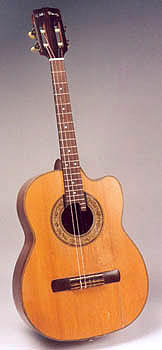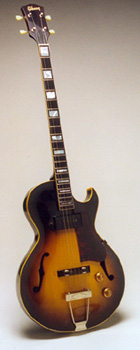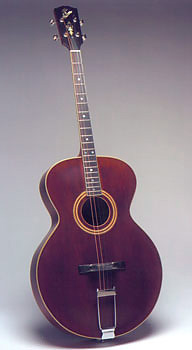Early tenor guitars were often built by simply attaching a tenor neck to a standard size guitar body. As tenors declined in popularity, many were converted to six string guitars, "enhancing" their value musically and monetarily. Now, as demand for tenor guitars again increases, some smaller six string guitars (but generally not rare vintage instruments) have become excellent candidates for conversion to tenors. Earnest Instruments specializes in tenor conversions, as well as building new bodies for orphaned tenor necks.

This Gibson 3/4 size ES 125 had been previously subjected to numerous botched repairs and "improvements" when it was acquired by Earnest Instruments. The old six string neck was removed and replaced by a tenor neck built in the Gibson style. The instrument was also rebound, refinished and rewired. The resulting guitar is a thin body archtop electric tenor, better proportioned than either Gibson's 3/4 size six strings or their full sized tenor guitars.

This short scale Mexican requinto was well played and well worn when its current owner, tenor banjoist Eddy Davis, decided to have it converted to a tenor guitar. The fingerboard was removed, narrowed, inlayed, and reglued after reinforcing the neck with a graphite epoxy rod. Built in the Spanish style, the guitar's neck could not be removed so it was recarved on the body. The headstock was shortened for four tuners, reglued, and reveneered on top and back to reinforce and hide the joint. "The Mex" is now a nylon string tenor guitar, well suited for ethnic, jazz, folk, or classical music.

Another of Gibson's 3/4 size archtop electrics, this 1950's guitar was in very good condition but the customer requested that it be converted to a plectrum guitar. I steamed off the original neck and replaced it with a 4 string mahogany neck with a two-way truss rod, keystone tuners, a bound ebony fretboard (26.25" scale) and block inlays. The result is a mini ES-175 style plectrum guitar ...lightweight, nicely proportioned, and with great access to the upper frets. Not exactly a factory item, but it looks like it could have been.

This guitar was a total basket case when it arrived in my shop. The sides were split from end to end, the neck block and heel were cracked and badly repaired, the bridge, tuners, and tailpiece were missing, and the finish was gone. But...the top and back were in good shape, so I slowly coaxed it back together with clamps and glue, rebound, recarved, and refinished it, and made a new tenor neck. Of course, Gibson didn't make tenor guitars back in 1912 (they weren't due to show up for another 15 years) so this instrument is now something of a... bastard case. Little did Gibson know that what made this a rather mediocre sounding archtop guitar, with a small body, round sound hole, short scale and a very fat 13 fret neck, makes it an excellent sounding tenor guitar, with a 23" scale, and a 12 fret adjustable neck. Over 90 years old, this well-used L-3 lives on. It almost looks like it was made this way.